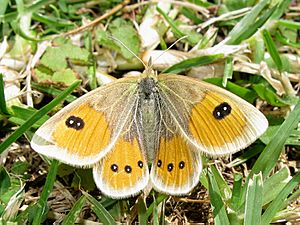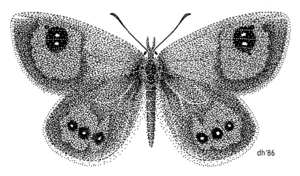Common tussock facts for kids
Quick facts for kids Common tussock |
|
|---|---|
 |
|
| Scientific classification |
The Argyrophenga antipodum, also known as the common tussock or tussock ringlet, is a type of butterfly. You can usually find it in the South Island of New Zealand.
Contents
About the Common Tussock Butterfly
The common tussock butterfly is about 12 to 17 millimeters (half an inch) long. Its wings can spread out to about 35 to 45 millimeters (1.5 to 1.8 inches). Male and female butterflies look a bit different. Females are shorter and have rounder bodies than males.
These butterflies have special silver streaks on the underside of their wings. These streaks help them blend in with their surroundings, which is a great way to hide from predators! The butterflies are mostly brown and red. They also have cool eyespots on their wings. These spots look like eyes and are thought to scare away animals that might want to eat them.
Males are usually darker, with more red and brown colors. Females are often more yellow. But both sexes have very similar patterns on their wings.
Where Do They Live?
Only in New Zealand
The common tussock butterfly is endemic to New Zealand. This means it's found naturally nowhere else in the world! You can spot it in the eastern, southern, and central parts of New Zealand's South Island. They are most common in areas like lowland Canterbury, Otago, and Southland. It's interesting that they don't seem to live in other parts of New Zealand, even if the habitat looks suitable.
Their Favorite Places to Be
You can find the common tussock butterfly in many different places. They live from sea-level saltmarshes and grasslands all the way up to high alpine zones (mountains) at nearly 2,000 meters (6,400 feet) high!
They are often found in both native and introduced grasslands, whether the grass is tall or short. You might also see them along roadsides near old forests. They love places where the grass isn't grazed by animals. Near the coast in Southland, they live in mixed habitats. These include salt marshes, swamps, and tussock grassland areas.
Life Cycle of the Butterfly
New common tussock butterflies hatch every year. You can usually see adult butterflies flying from late October to late March.
When they are young larvae (which are caterpillars), they are very good at hiding. They can camouflage themselves among different tall and short grasses. These grasses are their "host plants," meaning they eat and live on them. This amazing camouflage continues when they turn into pupae, also known as the chrysalis stage.
Male and female common tussock butterflies act differently. Males are known to fly fast and more often. Females are smaller and spend more time among flowers and grass. This is where they lay their eggs.
These butterflies usually fly from November to March. One study in central Otago showed many A. antipodum from late November to late February. They can also fly quite far! One male butterfly was found 1 kilometer (about half a mile) away from where it was first caught, just one week later.
What Do They Eat?
Both male and female common tussock butterflies have a slow, gentle way of flying. They usually fly close to the ground. This makes it easy for them to stop and feed often on different flowers and plants.
When they are caterpillars, they eat plants from the Poaceae family, which are grasses. Some of the specific grass types they eat include Poa, Festuca, and Agropyron species. They are known to munch on plants like Chionochloa rubra, meadow grass, Poa poiformis, snow tussock, and wood meadow-grass.
Threats to the Common Tussock Butterfly
Butterflies, including the common tussock, can be affected by insect parasites when they are caterpillars or pupae. There isn't a lot of specific information about what animals directly eat the common tussock butterfly.
However, studies show that many New Zealand butterflies at risk are found in the Canterbury area. These areas often have short-tussock grasslands, just like where A. antipodum lives. These grasslands are often on land that is easy to develop for other uses. This makes it hard to protect them from herbivores (plant-eating animals) and weedy plants that can take over. This is an indirect threat to the common tussock's survival, as their food and home might disappear. Also, the South Island has a lot of different animals, which could mean more general threats to the butterflies.
Cultural Importance
Butterflies are not very common in New Zealand. Because of this, the species that do live there are very important for keeping the natural world diverse. This is especially true for butterflies like the common tussock, which are found nowhere else.
The native Māori never used butterflies for traditional cultural purposes. However, the Māori word for butterfly is pūrerehua, or sometimes pupa. This word means "nod." It's because the butterfly's abdomen (the back part of its body) seems to nod back and forth when it flies.
Sometimes, children would play a game with pupae. They would ask their grandparents if they could hold the pupa. They would hold it gently between their thumb and finger and ask questions like, "Am I a good girl?" If the pupa bent its abdomen up, it meant "yes." If it bent its abdomen down, it meant "no."
Cool Facts!
Some scientists have wondered if the Argyrophenga antipodum might actually be several very similar species, not just one. However, other studies suggest it is indeed one species. They found that the wing patterns are very similar, the male parts are consistent, and different forms of the butterfly seem to blend into each other over time.
The common tussock butterfly is known to interact with various plant species. While the exact details of these interactions aren't always clear, they include plants from the bellflower family, the daisy family, the family Gentianaceae, and the genus Wahlenbergia.


